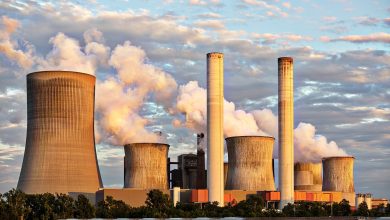Vermont’s Plan to Drastically Reduce Fossil Fuel Consumption

Fossil Fuel Company Struggles
Fossil fuel companies have publicly expressed concerns that investments in renewable energy will eventually outpace investments in fossil fuels. The downfall of fossil fuel companies like Exxon Mobil and Halliburton has been a sign of the difficulties that fossil fuel companies have experienced in recent years. The state of Vermont is aiming to create new challenges for fossil fuel companies.

Vermont’s Energy Plan
In 2011, the Vermont Department of Public Service published an energy plan that has listed a goal of having the state receive 90 percent of its energy needs from renewable sources by the year 2050. This is one of the most ambitious plans that a state has embarked on to remove fossil fuels from a statewide energy portfolio. The state has pledged to pursue this energy objective in order to reduce dependence on foreign fossil fuels, protect the environment, stimulate the local economy, and strengthen local communities.
During the process of reducing the amount of oil and gas used in energy production, state officials say that local jobs will be created, while concerns about the volatile price of fossil fuels will be alleviated. To convey how this goal will be achieved, the energy plan breaks down the specific strategies into separate sectors. Transportation and land use will arguably be some of the most challenging sectors to transform to achieve this energy vision.

Current Energy Challenges
Vermont’s energy plan details a major alteration to the state’s transportation system and the way that land is developed. Currently, Vermonters use a substantial amount of energy and money in order to drive great distances to access common services and amenities. The state has a severely limited public transit system because much of its population is spread across a rural landscape.
Because of its rural characteristics, Vermont has one of the highest automobile dependency rates in the country. A typical Vermonter uses 545 gallons of gasoline per year, which is nearly a hundred gallons more than the national average (Owen, 2009). Despite this transportation obstacle, the state still vows to reach its goal by switching to electric vehicles, building more efficient transportation infrastructure, and encouraging mixed development near central villages and downtown districts (State of Vermont, 2011).
State officials highlight that a critical element of the new land use plan will be to reduce the need for Vermonters to be automobile dependent. With the way that the state is currently developed, it would be nearly impossible for the citizens to just simply give up driving. However, the land use plan will encourage compact community planning so that local small-scale developments will be placed around town centers in order to support walkable communities where the citizens can live their daily lives without the need to use fossil fuels for transportation.

Shortening Trips
The most successful neighborhoods function as a village, which would be a place where many of one’s basic needs are within a short distance of home (Walljasper, 2010). The land use proposal transcends how Vermont towns will be retrofitted to increase energy efficiency, while also preserving the scenic beauty that attracts millions of tourists each year.
New York City would be an example of an area where effective planning has created a city that has a very low per capita carbon footprint. The average Manhattan resident only consumes 90 gallons of gasoline each year. The reason for this is because 77 percent of Manhattan households don’t own a car (Owen, 2009). Conversely, the percentage of no-automobile households in Vermont is remarkably small. Nevertheless, Vermont’s uniquely rural characteristics won’t allow for a transportation system like New York City’s.

Electric Vehicles
The Vermont Department of Public Service’s strategy for a green transportation system that is less dependent on fossil fuels begins by supporting the implementation of electric and alternative-fueled vehicles. State officials say that the next step would be the collaboration of regional planning commissions with local towns to create mixed-use development projects to reduce car dependency. Moreover, another strategy that is projected to reduce fossil fuel consumption is the state’s plan to triple the number of park-and-ride locations. Specialized new infrastructure will also be created to support new technologies such as charging stations for electric cars and alternative fuel pumps. Existing modes of transportation like freight and passenger rail systems will also be upgraded to support more travelers via less carbon-intensive modes.
Education and Financing
New strategies for financing and education are also being developed by Vermont to ensure that sufficient funding is available for the new transportation and development projects. For example, instead of using a gas tax, the state is evaluating a fee that could be charged based on the number of miles traveled. The state is also evaluating how to tax electricity that fuels electric vehicle charging. While the state has the goal of removing the vast majority of vehicles powered by fossil fuels, the state does not currently have a formalized plan to recuperate the lost revenue from the gas tax.
The Vermont Agency of Transportation and the Agency of Commerce and Community Development are aggressively moving forward with educational campaigns highlighting the importance of removing fossil fuels from the energy portfolio. Additionally, state agencies have been working to ensure that people are aware of land use and transportation goals, while also incentivizing programs related to car sharing and van pooling (State of Vermont, 2011).

Efficiency Vermont
The Vermont Department of Public Service is employing a program known as Efficiency Vermont to help achieve the state’s energy goal. Efficiency Vermont is the country’s first ratepayer-financed utility that provides statewide energy efficiency services. This energy efficiency program provides financial incentives and technical support in order to encourage Vermont’s businesses and homeowners to reduce their fossil fuel consumption by installing energy-efficient equipment, such as lighting, refrigerators, and dehumidifiers. Efficiency Vermont also works with contractors, distributors, and manufacturers that deliver energy-efficient products and services to Vermont businesses.
Efficiency Vermont is operated by the Vermont Energy Investment Corporation (VEIC), which is a nonprofit energy assistance organization under an appointment by the Vermont Public Service Board. This Vermont-based company has planned and applied energy efficiency programs throughout Vermont and in over 20 states and eight countries since 1986. Overall, VEIC is devoted to reducing the financial and ecological costs of energy usage through cost-effective energy efficiency technologies.
Distinctive Energy Utility
Efficiency Vermont is a distinctive energy utility that is unlike traditional electric companies because it functions to conserve energy, protect the environment, and save Vermonters money. Before Efficiency Vermont was created, traditional utilities charged for both energy usage and energy efficiency on ratepayers’ electric bills. Today, Efficiency Vermont adds an energy efficiency charge on Vermonters’ electric bills to provide funds for energy efficiency services. This switch has enabled Vermonters to receive a uniform and more comprehensive list of services that individual electric companies could not provide. The efficiency charge has removed energy efficiency services from the list of responsibilities that typical electric utilities must oversee. Besides simply aiming to reduce Vermont’s fossil fuel consumption with funds from an efficiency charge on electric bills, Efficiency Vermont will also play a pivotal role in achieving the Vermont Department of Public Service’s renewable energy goal.
Vermont’s energy plan specifically details that efficiency and conservation must be the first priority in order to meet the renewable energy goal. The plan conveys that it is more economically beneficial to lessen the current demand of energy by implementing energy-efficient equipment than it would be to increase the supply of renewable energy. Once efficiency has been established, then state officials say that the next priority would be to construct renewable energy generation projects. Additionally, energy efficiency initiatives are thought to have a direct benefit on the two large sectors of the plan that focus on transportation, home heating, and cooling.

A Push for Solar
In addition to energy efficiency projects to reduce the overall consumption of fossil fuels, Vermont has been pumping a tremendous amount of support for solar power. According to the U.S. Department of Energy, using the sun to generate electricity, heat, and natural lighting has become the most popular form of renewable energy. While solar power technology supplies less than one percent of global energy, each hour, the sun sends down more than enough energy to satisfy global power needs for an entire year (Imboden, 2012).
The Vermont Legislature passed a renewable energy bill into law that made it possible for the state to have one of the nation’s most streamlined processes for creating small-scaled solar projects. The law has made it easier for homeowners and businesses to install solar energy systems by eliminating the complicated process for permits and inspections. David Blittersdorf, the president and chief executive officer of Vermont-based AllEarth Renewables said, “Rather than wasting resources on cumbersome, time consuming and often costly permitting, the industry can spend more resources on innovation and performance, bringing down the cost of solar for more American families and businesses” (Zeller, 2011).
Vermont’s largest energy provider, Green Mountain Power, has championed solar projects like a 150-kilowatt solar development project in the City of Rutland. This project was the first to be planned under Green Mountain Power’s solar city initiative, in which it has made it a goal to make Rutland the city with the greatest solar capacity per capita in the northeast. The project was placed on a three-acre lot that formerly held a coal-to-gas plant. Rutland also has another even larger solar project in the planning process that would construct a two-megawatt development on a former city landfill property.
Solar Technology
Vermont receives 15 percent more sun on average than any location in Germany, yet Germany is the world leader in solar power generation as a percentage of its power sources (Brown, 2012). State officials in charge of energy point to this fact as proof that Vermont can indeed effectively utilize solar power instead of fossil fuels. Furthermore, solar power technologies are becoming increasingly efficient and cost effective, which is projected to eventually give this form of renewable energy a leg up when compared to traditional energy developed from fossil fuels. Many energy experts predict that continued research will allow solar electric systems to become more efficient, more reliable, and less costly for buyers.

Energy Plan Implementation
Vermont’s goal of obtaining 90 percent of its energy resources from renewable sources will not be attained unless a new system of land use and transportation is implemented. The strategies that are conveyed in Vermont’s published energy plan are projected to alleviate the state’s dependence on fossil fuels by promoting mixed-use development and alternative modes of transportation by electric car, train, or walking. Political officials say that obstacles such as the lack of public transportation and the rural landscape can be eased by promoting car sharing programs and the redevelopment of town centers to promote walkability. Upgrading low-carbon passenger trains is another strategy that the state believes could be a plausible way to travel longer distances throughout Vermont.
Overall, state leaders hope that the impact of these approaches to reduce fossil fuel consumption in Vermont will have a positive effect on the economy and the environment. Officials predict that new jobs will be created to support new infrastructure, the environment will be protected, and economic prosperity will be created for Vermonters. As Vermont moves forward with this ambitious renewable energy goal, other states around the country are likely to join in on similar pledges against fossil fuels.
Sources
Brown, G. (2012). “Vermont’s Energy Future and The Role for Solar Power.” Vermont Commons.
Imboden, O. (2012). “Solar Energy.” National Geographic.
Owen, D (2009). “Greenest Place in the U.S.? It’s Not Where You Think.” Yale University: Yale Environment 360.
State of Vermont. (2011). “Vermont’s Comprehensive Energy Plan.” State of Vermont Department of Public Service.
Walljasper, J. (2010). “In Praise of Urban Density and Mixed Development.” Natural Resources Defense Council: Smarter Cities.
Zeller, T. (2011). “Vermont Streamlines Small-Scale Solar Power.” Huffington Post.



